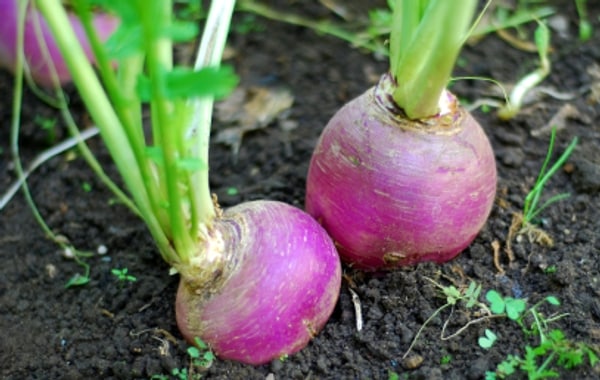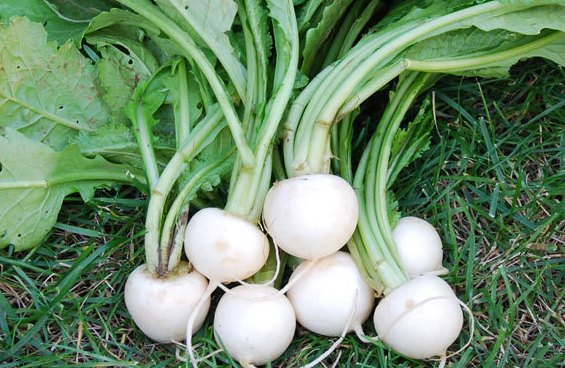A step by step guide for Turnip farming practices
Today, we learn the turnip farming practices, planting methods, plant care, harvesting process, and the yield.

Introduction of Turnips:
The turnip or white turnip is a root vegetable is generally grown in temperate climates, tropical and subtropical regions of India for its white, bulbous taproot. The most common type of turnip is colored in white. This root vegetable belongs to the family of “Brassicaceae” and genus of “Brassica”. The small and tender roots are used for the culinary purpose whereas bigger size turnips are used as animal feed.
Health Benefits of Turnips:
Following are some of the health benefits of Turnips.
- Turnips may help in cancer prevention.
- Turnips are good for heart health.
- Turnips have anti-inflammatory properties.
- Turnips are a good source of antioxidants.
- Turnips support in bone health.
- Turnips are good source fiber.
- Turnips are good for digestive health.
- Turnips aid in weight loss.

Local names for Turnips in India:
Shalgam (Hindi), Salgam (Marathi), Tella Dumpa (Telugu),Knolkol (Tamil),Navil Kosu (kannada), Salgum (Assamese), Shalgom (Bengali), Shalgam (Punjabi, Oriya), Madhura mullangi (Malayalam), and Salagama (Gujarati).
You should not miss the Sheep Farming Business Plan.
High Turnip Production Sates of India:
Bihar, Punjab, Himachal Pradesh, Tamil Nadu, and Haryana.
Types and Varieties of Turnips in India:
Turnip varieties are categorized into two main groups. They are Asiatic or Tropical type & Temperate or European type. These two groups further classified based on root shape, skin and flesh color. However, the turnip varieties preferred for commercial cultivation are given below.
- Early Milan Red Top
- Purple Top White Globe
- Punjab Safed 4
- Golden Ball
- Snow Ball
- Pusa Sweti
- Pusa Kanchan
- Pusa Swarnima
- Pusa Chandrima
Climate Requirement for Growing Turnips:
Turnips thrive best in cool and moist climatic conditions. These root vegetables can be grown even in the areas where summer temperatures are moderate. The optimum temperature range of 10 °C to 16°C is ideal for the development of good root texture, best flavor, and excellent size. It requires short day lengths and cool climate for better development of roots. The Asiatic type of turnip tolerates high temperature whereas the temperate type of turnip thrives well in cool climatic conditions.
Soil Requirement for Turnip Production:
Turnip vegetable can be cultivated in a wide range of soils. However, well-drained sandy loam soils with high in humus are the best for its cultivation. Very light sandy soils or too heavy soils are not suitable for its cultivation.
Land Preparation in Turnip Plantation:
In turnip farming, land preparation would be the same as radish farming. Give a couple of plows to bring the soil to the fine tilth stage and weed-free. supplement the soil with appropriate well rotten farmyard manure (FMY) (25 tonnes /ha).
You may also like Hybrid Coconut Cultivation; Yield; Varieties.
Propagation of Turnips:
Turnips are propagated through seeds.
Sowing, Spacing, and Planting of Turnips:
The sowing time for the Asiatic type of turnips is best from July to Sept whereas for Temperate or European type of turnips from Oct to Dec in the plains. In hills regions, the best sowing season is from July to Sept. Generally, Turnip seeds are sown directly either in ridges or lines prepared during the land preparation. Usually, flatbeds are used for sowing the turnip seeds. However, in low lying regions or during monsoon, it should be done on ridges.
Turnip seeds should be sown on ridges or rows @ 30 cm apart while keeping the row-to-row distance of 6 to 7 cm. usually, seeds are sown at 1.5 cm depth and seeds should be mixed with sand for uniform sowing.
In turnip cultivation, seeds can germinate within a week and the success of seed germination is about 90%. Thinning should be carried out after 2 weeks of germination. The turnip plants should be placed @ 12 to 15 cm within the row.
Manures and Fertilizers for Turnip Crop:
Apply farmyard manure (FMY) of 25 tonnes/ha as basal dose at the time of land preparation.
Apply “N” @ 80 to 100 kg/ha, “P” @ 50 kg/ha, “K” @ 50 kg/ha. The full dose of P & K, a half dose of “N” should be applied before sowing the seeds. The leftover “N” should be applied in 2 split doses with one is at the time of root formation and the 2nd dose at the time of root knobs development. Phosphatic and potassic fertilizers should be applied at 8 cm depth before sowing the seeds. In the case of micronutrient deficiency, Spray the 1kg/ha of Micnelf MS-24 one or two times based on the requirement.
Irrigation for Turnip Plantation:
Irrigation should be carried out as soon as seeds are sown and the frequency of irrigation depends on the soil moisture-holding capacity and climate conditions. Generally, to maintain optimum moisture, Irrigation should be given at 8 to 10 days intervals. Mulching also retains good moisture content in the soil apart from preventing weed growth. In the rainy season, there is no need for any irrigation. In case of heavy rains or floods, make sure to drain out the water from the soil.
Weed Control in Turnip Production:
About 3 hoeings can be given to control the weeds in the turnip plantation. The earthing up should be done during 2nd & 3rd hoeing after the top dressing application of “N” fertilizers for producing quality roots. Total of 3 weedings is required in turnips farming till the harvesting time. Herbicides like Tok E-25 @ 2 kg/ha can be used as a pre-emergence application to control the weeds effectively.
When and How to Harvest Turnips:
Turnips will be ready for harvesting when tender roots are uprooted with good size. Usually, the turnip roots are harvested when they are about 6 to 10 cm in diameter depending on the turnip variety cultivated. If turnips are not harvested at the right time, they become tough & fibrous. Harvesting is preferred in the evening.
The Yield of Turnips:
Yield depends on the variety and soil type, climate conditions along with the farm management practices. In turnips farming, an average yield of 250–400 quintals/ha can be obtained.
You may be interested in Growing Radish, Planting, Care, Harvesting.
That’s all folks about the farming of turnip along with cultivation practices. If you have any questions, don’t hesitate to drop a comment below. Keep farming veggies!.